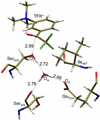Acetylcholinesterase: mechanisms of covalent inhibition of H447I mutant determined by computational analyses
- PMID: 18657802
- PMCID: PMC2576475
- DOI: 10.1016/j.cbi.2008.04.044
Acetylcholinesterase: mechanisms of covalent inhibition of H447I mutant determined by computational analyses
Abstract
The reaction mechanisms of two inhibitor TFK(+) and TFK(0) binding to H447I mutant mouse acetylcholinesterase (mAChE) have been investigated by using a combined ab initio quantum mechanical/molecular mechanical (QM/MM) approach and classical molecular dynamics (MD) simulations. TFK(+) binding to the H447I mutant may proceed with a different reaction mechanism from the wild-type. A water molecule takes over the role of His447 and participates in the bond breaking and forming as a "charge relayer". Unlike in the wild-type mAChE case, Glu334, a conserved residue from the catalytic triad, acts as a catalytic base in the reaction. The calculated energy barrier for this reaction is about 8kcal/mol. These predictions await experimental verification. In the case of the neutral ligand TFK(0), however, multiple MD simulations on the TFK(0)/H447I complex reveal that none of the water molecules can be retained in the active site as a "catalytic" water. Taken together our computational studies confirm that TFK(0) is almost inactive in the H447I mutant, and also provide detailed mechanistic insights into the experimental observations.
Figures



Similar articles
-
Acetylcholinesterase: mechanisms of covalent inhibition of wild-type and H447I mutant determined by computational analyses.J Am Chem Soc. 2007 May 23;129(20):6562-70. doi: 10.1021/ja070601r. Epub 2007 Apr 27. J Am Chem Soc. 2007. PMID: 17461584
-
1-(3-Tert-Butylphenyl)-2,2,2-Trifluoroethanone as a Potent Transition-State Analogue Slow-Binding Inhibitor of Human Acetylcholinesterase: Kinetic, MD and QM/MM Studies.Biomolecules. 2020 Nov 27;10(12):1608. doi: 10.3390/biom10121608. Biomolecules. 2020. PMID: 33260981 Free PMC article.
-
Catalytic reaction mechanism of acetylcholinesterase determined by Born-Oppenheimer ab initio QM/MM molecular dynamics simulations.J Phys Chem B. 2010 Jul 8;114(26):8817-25. doi: 10.1021/jp104258d. J Phys Chem B. 2010. PMID: 20550161 Free PMC article.
-
Progress in ab initio QM/MM free-energy simulations of electrostatic energies in proteins: accelerated QM/MM studies of pKa, redox reactions and solvation free energies.J Phys Chem B. 2009 Feb 5;113(5):1253-72. doi: 10.1021/jp8071712. J Phys Chem B. 2009. PMID: 19055405 Free PMC article. Review.
-
[The fasciculin-acetylcholinesterase interaction].J Soc Biol. 1999;193(6):505-8. J Soc Biol. 1999. PMID: 10783708 Review. French.
Cited by
-
Computational Studies on Acetylcholinesterases.Molecules. 2017 Aug 10;22(8):1324. doi: 10.3390/molecules22081324. Molecules. 2017. PMID: 28796192 Free PMC article. Review.
-
Mapping of the interaction sites of galanthamine: a quantitative analysis through pairwise potentials and quantum chemistry.J Comput Aided Mol Des. 2012 Oct;26(10):1111-26. doi: 10.1007/s10822-012-9602-x. Epub 2012 Sep 13. J Comput Aided Mol Des. 2012. PMID: 22972560
References
-
- Rosenberry TL. Acetylcholinesterase. Adv. Enzymol. Relat. Areas Mol. Biol. 1975;43:103–218. - PubMed
-
- Schumacher M, Camp S, Maulet Y, Newton M, Macpheequigley K, Taylor SS, Friedmann T, Taylor P. Primary structure of acetylcholinesterase - implications for regulation and function. Fed. Proc. 1986;45:2976–2981. - PubMed
-
- Taylor P. The Pharmacological Basis of Therapeutics. New York: MacMillan; 1985.
-
- Contestabile A, Fila T, Bartesaghi R, Contestabile A, Ciani E. Choline acetyltransferase activity at different ages in brain of ts65dn mice, an animal model for down's syndrome and related neurodegenerative diseases. J. Neurochem. 2006;97:515–526. - PubMed
-
- Piazzi L, Rampa A, Bisi A, Gobbi S, Belluti F, Cavalli A, Bartolini M, Andrisano V, Valenti P, Recanatini M. 3-(4-{[benzyl(methyl)amino]methyl}-phenyl)-6,7-dimethoxy-2h-2-chromenone (ap2238) inhibits both acetylcholinesterase and acetylcholinesterase-induced beta-amyloid aggregation: a dual function lead for alzheimer's disease therapy. J. Med. Chem. 2003;46:2279–2282. - PubMed
Publication types
MeSH terms
Substances
Grants and funding
LinkOut - more resources
Full Text Sources

